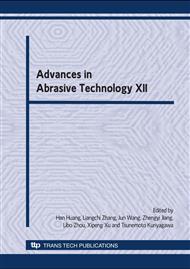p.635
p.641
p.645
p.651
p.657
p.664
p.673
p.678
p.684
Effects of Combined Ultrasonic Vibration during the Sinking EDM Process for Cemented Carbide
Abstract:
In recent years, to improve the electrical discharge machining properties, several trials have been applied with the ultrasonic vibration system which was combined on the sinking electrical discharge machine. In this paper, the effects of the ultrasonic vibration were investigated with the designed sinking EDM machine. Some experimental parameters of tool electrode polarity, rotational workpiece speed and directions were examined during the sinking EDM process on the cemented carbide material of G5. Material removal rate, electrode wear ratio and surface roughness were estimated as the machining properties under finishing machining conditions. The experiments were carried out on ultrasonic longitudinal frequency 59 kHz and electrode spindle till 1,000 rpm. Two rotational apparatuses were used simultaneously on the opposite rotational direction during discharge machining. The discharge conditions were estimated with the waveforms analysis. As the results, the EDM device system which was combined ultrasonic vibration, improved the material removal rate and surface roughness of the EDMed workpiece.
Info:
Periodical:
Pages:
657-663
Citation:
Online since:
June 2009
Price:
Сopyright:
© 2009 Trans Tech Publications Ltd. All Rights Reserved
Share:
Citation:


